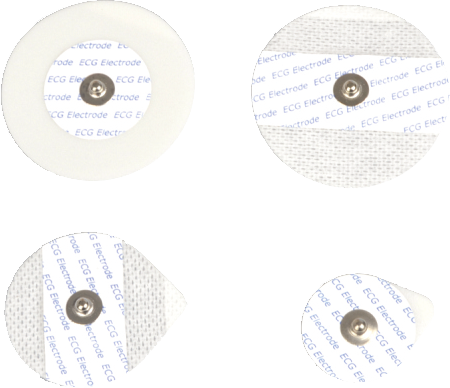
Disposable ECG Electrode
ECG, or electrocardiography, is a type of electrical activity that records heartbeats and displays them as waves on a screen.
Disposable ECG electrodes, which are used for various ECG tests in diagnostic or monitoring, It uses an Ag/AgCl sensor element and solid conductive & adhesive hydro-gel for adhesion.
The Ag/AgCl sensor element has the best sensitivities and the solid conductive & adhesive hydro-gel has very low impedance and is non-irritating, non-sensitizing and non-cytotoxic to the skin. All electrodes are Latex free.
There are a few different types of ECG electrodes, but they all work in basically the same way. The electrodes are placed on the skin and then connected to an ECG machine. When the machine is turned on, it will send out a small electrical current that will flow through the electrodes and into the patient's body. This current will cause the heart to produce a small electrical signal that can be detected by the ECG machine. The machine will then use this signal to create a tracing of the patient's heartbeat. This tracing can be used to diagnose various heart conditions, such as arrhythmias or heart attacks. ECG electrodes are generally safe for most patients. However, there are some risks associated with their use. These risks include skin irritation, burns, and electrical shocks. Patients should always talk to their doctor before having an ECG test to make sure that it is right for them.
There are a few places on the body where ECG electrodes can be placed in order to help diagnose your health. These include:
-On the chest: This is the most common place to put ECG electrodes. They are usually placed on the left side of the chest, near the heart.
-On the arms: ECG electrodes can also be placed on the arms, near the elbow. This is often done when diagnosing heart conditions.
-On the legs: ECG electrodes can also be placed on the legs, near the knee. This is often done when diagnosing blood circulation problems.
In order to understand what an ECG is and how it works, it is first necessary to know a little bit about the different types of ECG electrodes. There are three main types of ECG electrodes:
1) The first type of electrode is called the positive electrode. This electrode is placed on the patient's skin and sends positive electrical charges to the heart.
2) The second type of electrode is called the negative electrode. This electrode is also placed on the patient's skin but sends negative electrical charges to the heart.
3) The third and final type of electrode is called the ground electrode. This electrode is placed on the patient's skin but does not send any electrical charges to the heart. Instead, it serves as a reference point for the other two electrodes.
Now that you know a little bit about the different types of ECG electrodes, let's take a look at how they are used in order to diagnose your health.
There are many advantages of using ECG electrodes to diagnose your health. They are a non-invasive way to test for heart conditions and can be used on patients of all ages. Electrodes can also be placed on different parts of the body to get a more accurate reading. ECG electrodes are also very portable, so you can take them with you wherever you go. This makes it easy to keep track of your heart health and get immediate readings if something changes. Another advantage of ECG electrodes is that they are relatively inexpensive. This means that more people can have access to this important diagnostic tool. Overall, ECG electrodes offer a convenient, affordable, and accurate way to diagnose heart conditions. They are an essential tool for anyone concerned about their heart health.
1. ECG electrodes can be uncomfortable to wear.
2. They can also cause skin irritation.
3. You may have to take them off frequently to shower or swim.
4. They can be expensive.